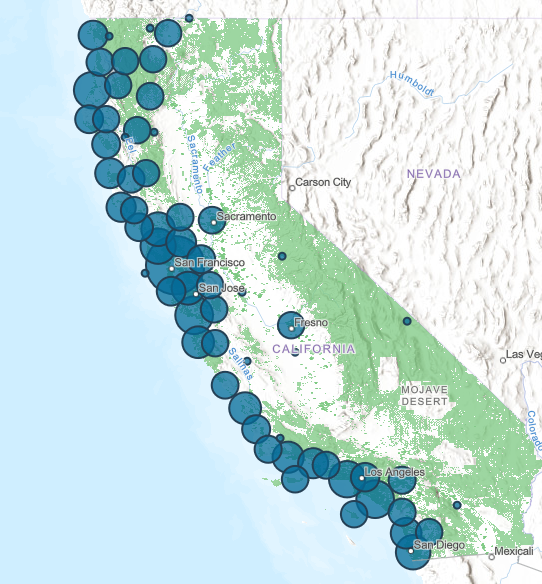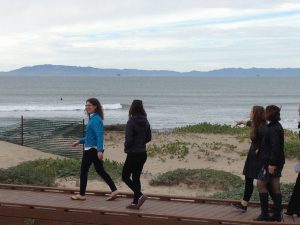Case Studies of Natural Shoreline Infrastructure in Coastal California
New Case Studies show potential of nature-based infrastructure to mitigate sea level rise.
Sea level rise and associated flooding will threaten nearly $100 billion worth of property along the California coast by 2100, and there is no question that coastal landowners and planners will act to protect their assets from these losses. In the absence of compelling reasons or guidance to do otherwise, they will overwhelmingly default to the industry standard – specifically, the construction of coastal armoring (seawalls, revetments, dikes, and levees).
One alternative to coastal armoring is natural infrastructure, which has been shown to be a cost-effective approach to mitigating risk of floods, storms and sea level rise in many places. Natural infrastructure enhances the ability of natural systems to respond to sea level rise and migrate landward, ensuring their survival. In turn, these systems provide co-benefits for coastal communities: coastal ecosystems can serve as protective buffers against sea level rise and storm events while continuing to provide access, recreation opportunities, and other social benefits.
In spite of the well-known advantages of natural infrastructure, property owners continue to default to coastal armoring to protect their assets. There are a number of obstacles in deploying natural infrastructure that result in this preference for coastal armoring, but among them is a documented lack of familiarity with what natural infrastructure is and how it works.
Ironically, California already has numerous examples of natural infrastructure at work! In order to fill this awareness gap, a team of experts from The Nature Conservancy, Point Blue Conservation Science, Environmental Science Associates, the State Coastal Conservancy, and the NOAA Sentinel Site Cooperative have released a report with detailed case studies of coastal natural infrastructure in action. These projects, ranging from sediment augmentation in Seal Beach to dune restoration in Humboldt, are designed to give coastal managers a sense of the breadth of approaches to coastal adaptation and what it takes to plan, permit, implement, and monitor them.
Five projects that spanned the California coast and represented different coastal settings and corresponding approaches were selected for the purposes of this report:
- Seal Beach National Wildlife Refuge Thin-layer Salt Marsh Sediment Augmentation Pilot Project
- Surfers’ Point Managed Shoreline Retreat Project
- San Francisco Bay Living Shorelines: Nearshore Linkages Project
- Hamilton Wetland Restoration Project
- Humboldt Coastal Dune Vulnerability and Adaptation Climate Ready Project
The case studies investigation was conducted as a component of “Identification of Natural Infrastructure Options for Adapting to Sea Level Rise,” a project under California’s Fourth Climate Assessment.
Read the full report: Case Studies of Natural Shoreline Infrastructure in Coastal California
Latest News
- Press Release: Coastal Conservancy Awards over $40 million for coastal access, restoration, and climate resilienceOakland, CA (4/18/2024) – Today, the Board of the State Coastal Conservancy approved grants totaling over $40 million for coastal access, restoration, and climate resilience. Among the grants awarded today are: A grant of up to $6,000,000 to Humboldt County Resource Conservation District to undertake the North Coast Wildfire Resilience Planning and Implementation Grant Program, which […] (Read more on Press Release: Coastal...)
- Sea Otter Recovery Grants RFP Now Open!The California State Coastal Conservancy announces the availability of grants to public agencies, tribes and nonprofit organizations for projects that facilitate the recovery of the southern sea otter along California’s coasts. The California Sea Otter Fund is one of the state’s tax check-off funds that allows taxpayers to voluntarily contribute to the recovery of California’s […] (Read more on Sea Otter Recovery...)
- Coastal Conservancy Public Meeting in Oakland – April 18Meeting Notice Douglas Bosco (Public Member), Chair Marce Gutiérrez-Graudiņš (Public Member), Vice Chair Joy Sterling (Public Member) Jeremiah Hallisey (Public Member) Wade Crowfoot, Secretary for Natural Resources; Bryan Cash and Jenn Eckerle (Designated) Caryl Hart, Coastal Commission Chair; Madeline Cavalieri (Designated) Joe Stephenshaw, Director, Department of Finance; Michele Perrault (Designated) Senate Representatives Benjamin Allen (District […] (Read more on Coastal Conservancy Public...)

 Help Save Sea Otters at Tax Time
Help Save Sea Otters at Tax Time


